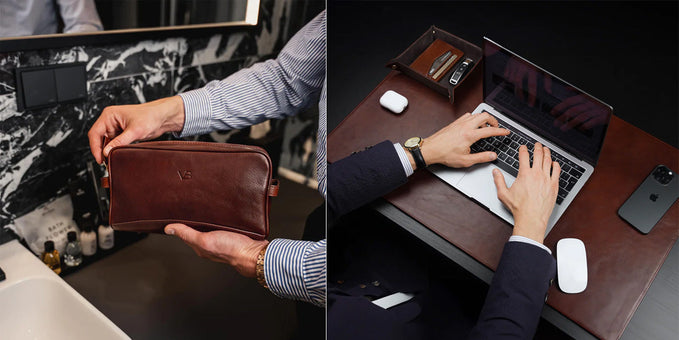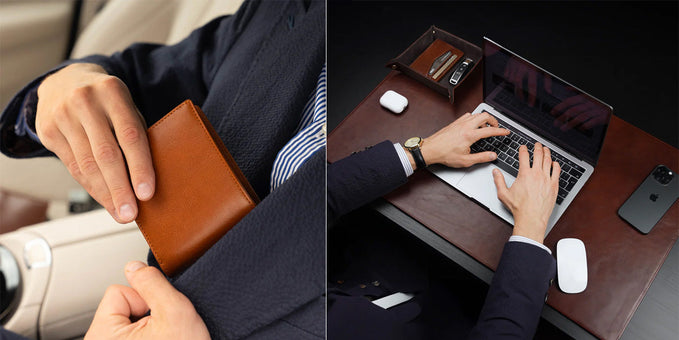How To Carry Your Briefcase

Summary: Carry your briefcase by the handle for a professional look in the office, and use a shoulder strap for comfort during commutes.
A crossbody style strap is best to distribute the weight evenly on longer journeys and help with proper posture.
Read on for a more detailed analysis with examples:
Professional Context: Align Your Style to the Environment

Image of the No.1 Briefcase held by the top handle.
Your bag handling should work well with your workplace’s cultural tone:
- In traditional corporate environments (consulting agencies, legal firms, or financial institutions), a hand-held grip will signal authority and discipline (source). Holding the bag close to your body to demonstrate c ontrol and reliability.
- In creative fields or tech environments, a casual shoulder strap placement helps you create a balance between professionalism and accessibility. Make sure that your strap is manufactured from high-quality materials such as leather or canvas, and avoid overly casual actions, including slinging the bag behind your back.
Related: Which Briefcase Color is Most Appropriate?
Posture: Silently Exuding Confidence

Image of the CITY Large and Essential bags held by the top handles.
Posture influences the impression you make:
- Keep your shoulders back and head high, with your arm holding the case slightly bent.
- During long walks, alternate the hands every 15-20 minutes to stop yourself from appearing strained or distracted.
Tip: Before you step into a room, pause for a moment to adjust your grip and posture. This helps you convey composure.
Which Carrying Style Is Most Comfortable?

Image of the No.2 Briefcase carried via the handle and via the shoulder strap.
Comfort can change how you move, present yourself, and interact.
If you misjudge your carrying style, this can shift the focus away from your goals, undermining your overall presence.
1. Hand-Held Carry: A Classic Approach
This classic option shows formality while communicating control. To perfect this technique:
- Grip Choice:Don’t clutch the handle too tightly, as this can make you appear tense. Use a firm but relaxed grip to show calm authority.
- Handle Material: Make sure that the handle is padded or ergonomically designed. This will prevent discomfort during extended use. Make a small investment in quality to prevent fatigue, especially during consecutive meetings or long walks from one office to another.
2. Shoulder Strap: Practical But Polished
Although a shoulder strap can be convenient, it can cause problems if it's worn incorrectly. To improve style and comfort:
- Adjust for Symmetry: Keep your strap snugly fitted to stop the bag from swaying when you walk. A wildly swinging bag can compromise an otherwise polished appearance.
- Protect Your Clothing: The placement of the strap can cause wrinkles or scuffs on your jacket. Choose a strap lined with smooth material, or consider switching to a hand-held carry when attending formal meetings.
3. Crossbody Carry: A Strategic Choice
While it can be seen as casual, crossbody carrying is a great solution for extended commutes or high-mobility roles.
Make sure that the strap crosses your chest at an angle that balances the weight evenly across the body but won’t compress your blazer or suit.
Need inspiration? Browse Von Baer luxury briefcases here.
Insider Tip: When using crossbody carry, opt for a slimmer design to prevent the kind of bulky, backpack-like silhouette that can detract from your professional image.
See our related guide on types of briefcases here.
Prefer video? See our briefcase video guide:
Maintain a Polished Look

Image shows the CITY Laptop Bag.
The way you handle and position your work bag during your interactions reflects your respect for others and how aware you are of the wider environment.
Entering a Room: A Smoother Introduction
When you’re walking into an event or meeting:
- Ensure your bag is angled slightly inward so you can avoid brushing against furniture or doorframes.
- Don’t over-swinging your arm, as this can make your presence appear less composed.
Meeting Placement: Out of Sight Yet Neatly Positioned
During meetings, proper placement is essential:
- Don’t rest the bag on the table, as this can appear intrusive or cluttered.
- Place the bag upright by your chair so it doesn’t block walkways.
- In particularly important meetings, position the bag discreetly near your dominant hand so you can get swift access to materials without fumbling around.
Navigating Crowded Spaces: Preventing Missteps
In elevators, elevators, or networking events:
- Hold your bag in front of you slightly to one side to prevent accidental bumps or encroaching on other people’s personal space.
Advanced Tip: When you’re sitting in public spaces such as airport lounges, don’t place your bag directly on the ground. Instead, you can choose a nearby seat or your lap to prevent wear and show that you value your professional equipment.
Briefcase material has a big impact here (learn more).
Optimize Your Briefcase for Everyday Use

Image of the internal compartments of the No.1 and Essential briefcases.
A perfectly organized bag ensures that you’re prepared for any scenario. This encourages trust and shows you’re dependable.
1. Curate with Firm Intention
Excess items cause clutter and inefficiency. Use the “two-zone” rule to prevent this:
- Primary Zone: Dedicate this space to your most important necessities like your laptop, phone, and vital documents. Make sure this area is always easy to access for smooth transitions between tasks.
- Secondary Zone: Use separate compartments for items you need less urgently and regularly, like business cards, umbrellas, or backup chargers.
2. Upgrade Your Essentials
Compact, high-quality goods make you more efficient:
- Replace bulkier chargers with slimmer, more travel-friendly versions.
- Select lightweight folders over heavy binders to streamline your document storage.
3. Weekly Reset Ritual
Dedicate 10 minutes at the end of every working week to declutter and restock your bag. This will make sure you’re prepared for the following working week without carrying unnecessary goods or disorganized materials.
Pro Insight: Keeping a small microfiber cloth in your work bag is ideal for situations where you need to wipe off smudges from the bag, your screen, or your glasses. This small touch shows others how meticulous you are.
We have a detailed briefcase compartment guide here.
Practical Considerations for Weather and Weight Management

Image shows the exterior pocket of the CITY Large.
1. Prepare for Weather Challenges
- Rain Protection: Use a waterproof cover or opt for a water-resistant bag. If you have a leather bag, protective sprays can be used to maintain its finish.
- Snow or Dust: A crossbody or shoulder strap ensures you can keep one hand free when you need to move across uneven or icy surfaces.
2. Don’t Overpack
Carrying a heavy bag can put a strain on your hand, shoulder, or back. If your role requires you to carry substantial loads, you could buy a briefcase with wheels or a convertible option with backpack straps (source).
- Organize Strategically: Place the heaviest items at the bottom or closer to your body to boost balance.
Adapt to Changing Needs

Image shows the locking feature of the No.1 briefcase.
The way you adjust how you carry and use your professional bag reflects your professional adaptability.
For Hybrid Work Models
In workplaces where office days alternate with remote days:
- Opt for a lightweight, convertible design that has detachable straps or expandable compartments so you can accommodate various load sizes.
For Frequent Travel
If your job demands constant movement:
- Invest in a rolling bag that comes with retractable handles to preserve energy while maintaining a professional and polished appearance. Opt for versions that feature TSA-approved laptop compartments so you can coast through security checks.
For Networking Events
During conferences or networking events:
- Choose a slim portfolio case to hold essentials like business cards, a tablet, and a pen—this helps you avoid the bulk of a large bag.
Real-World Strategy: At networking events, take a close look at how others handle their professional bags. You can refine your approach by following effective techniques that align with your brand.
Summary Takeaway
When you carry a professional bag, it’s not just an act of utility. It’s a strong reflection of your professional identity.
You can match each detail with your unique personal brand by mastering your carrying style, organizational skills, adaptability, and posture.
Each adjustment that you make will show that you’re prepared, aware, precise, and firmly positioned for success.

Author: Igor Monte
Igor Monte is the co-founder of Von Baer. He's an expert in all things premium leather, from being an end-user right up to the design and manufacturing process. His inside knowledge will help you choose the best leather product for you.
We strive for the highest editorial standards, and to only publish accurate information on our website.
Leave a Comment
Your email address will not be published.






